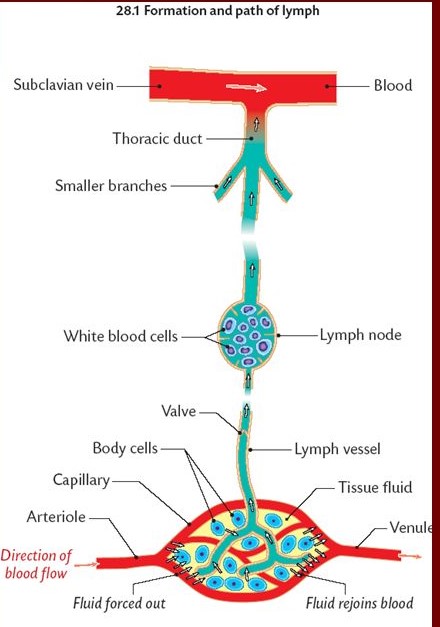Table of Contents
What is Lymph ?
Lymph is a clear, watery fluid found in the lymphatic system of Humans and Animals that is involved in Transportation. Its primary function is to act as a filter against microbes, toxins, organic wastes and debris, carrying lymphocytes that fight against infections.
Composition of Lymph

- Lymph plasma, lymph corpuscles, and lymphoid organs comprise the lymphatic system.
- Lymph plasma has a mineral content similar to that of plasma but contains fewer blood proteins, less calcium and phosphorus, and a high glucose concentration.
- It also contains globulin proteins, which act as antibodies, and other organic and inorganic substances.
- Lymph corpuscles include leucocytes and specialized lymphocytes that elicit immune responses.
- Lymphoid organs such as lymph nodes, spleen, tonsils, adenoids, and thymus form a part of the lymphatic system, filtering and circulating lymph throughout the body.
Also Check -Composition of Lymph in details
Also Check – 13 Important Differences between Lymph and Blood
Components of Lymph
Key components of lymph include:
- White blood cells – Lymph contains various types of white blood cells, including lymphocytes, monocytes and neutrophils. These cells help to defend the body against infection and disease by attacking and destroying invading microorganisms.
- Proteins – Lymph contains a variety of proteins (albumin, globulin, and fibrinogen), non-protein nitrogenous substances, including antibodies, enzymes and hormones. These proteins help to fight infection, maintain fluid balanceand regulate immune function.
- Lipids – Lymph also contains small amounts of lipids including cholesterol and triglycerides.
- Other substances – Lymph may also contain other substances such as electrolytes, enzymes and hormones. These substances help to maintain homeostasis in the body and support various physiological functions.
Also Check – What is Lymphatic System Class 10
Also Check – How Lymph is Formed ?
Formation of Lymph

- Lymph is produced by the lymphatic system a network of vessels and organs that includes the lymph nodes, spleen and tonsils
- It is formed when some amount of plasma, proteins and blood cells escape into intercellular spaces in the tissues through the pores present in the walls of capillaries.
- Lymph is formed from interstitial fluid due to the permeability of lymph capillaries. Lymph from the intercellular spaces drains into Lymphatic capillaries which further join to form large lymph vessels that finally open into larger veins.
- The lymph flows in these vessels due to contraction of the surrounding muscles. This again is a beneficial effect of physical exercise.
- The lymph vessels on the way drain lymph into lymph nodes from where fresh lymph channels arise and ultimately pour the lymph into the major anterior veins close to their entry into the right auricle and is again in circulation.
Lymph is similar to plasma of blood but is colorless and contains less proteins.
Also Check – Difference between Lymph and Plasma
Functions of Lymph
(i) Nutritive :
Supplies nutrition and oxygen to those parts where blood cannot reach.
(ii) Drainage :
It drains away excess tissue fluid and metabolites and returns proteins to the blood from tissue spaces.
(iii) Absorption :
Fats from the intestine are absorbed through lymphatics (lacteals locatedin the intestinal villi.)
(iv) Defense :
- Lymphocytes and monocytes of the lymph function to defend the body.
- The lymphatics also remove bacteria from the tissues.
Also Check – 15 Important Functions of Lymph
Haven’t you ever experienced painful swellings in your groins or in the axils of arms when you get a boil or injury in the limbs ?This is a protective sign. The lymph nodes tend to localize the infection and prevent it from spreading to the body as a whole.The tonsils on the sides of the neck are also lymph glands.
Also Check – Human Circulatory System
Similar Question and Answers
Question- What is Lymph and where is it found in the body?
Answer- Lymph is a clear, watery fluid found in the Lymphatic system of humans and animals. It is involved in Transportation and primarily acts as a filter against microbes, toxins, organic wastes and debris, carrying Lymphocytes that fight against infections.
Question- What are the key components of Lymph?
Answer- The key components of Lymph include white blood cells, proteins (such as albumin, globulin and fibrinogen), non-protein nitrogenous substances (including antibodies, enzymes and hormones), lipids (including cholesterol and triglycerides) and other substances such as electrolytes, enzymes and hormones.
Question- How is Lymph formed?
Answer- Lymph is formed when some amount of plasma, proteins and blood cells escape into intercellular spaces in the tissues through the pores present in the walls of capillaries. Lymph is formed from interstitial fluid due to the permeability of Lymph capillaries. Lymph from the intercellular spaces drains into Lymphatic capillaries which further join to form large Lymph vessels that finally open into larger veins. The Lymph flows in these vessels due to contraction of the surrounding muscles.
Question- What are the functions of Lymph?
Answer- The functions of Lymph include- (i) nutritive, supplying nutrition and oxygen to those parts where blood cannot reach; (ii) drainage, draining away excess tissue fluid and metabolites and returning proteins to the blood from tissue spaces; (iii) absorption, absorbing fats from the intestine through Lymphatics; and (iv) defense, defending the body through Lymphocytes and monocytes that remove bacteria from the tissues.
Question- What are Lymphoid organs and how do they function in the Lymphatic system?
Answer- Lymphoid organs such as Lymph nodes, spleen, tonsils, adenoids and thymus form a part of the Lymphatic system, filtering and circulating Lymph throughout the body. These organs contain Lymphocytes and specialized Lymphocytes that elicit immune responses and help defend the body against infection and disease.


11 Comments on “What is Lymph Class 10th”